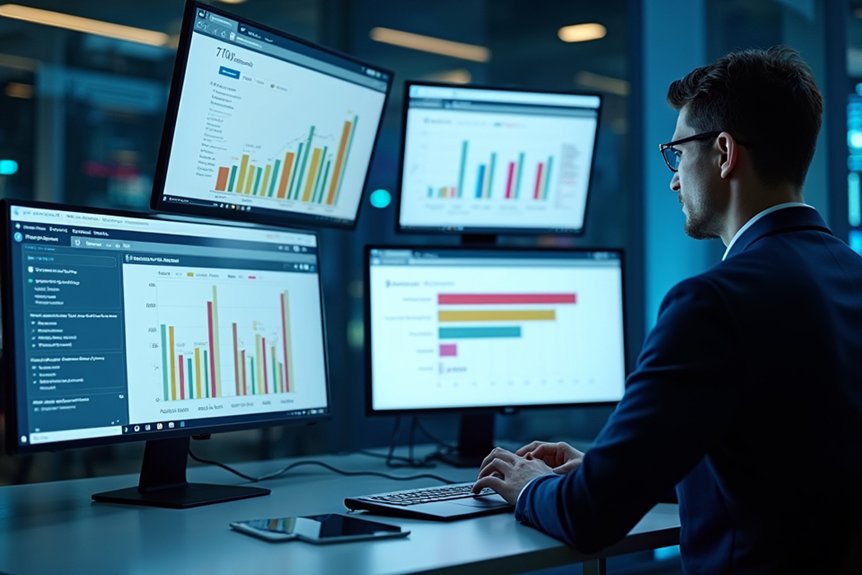In today’s competitive cybersecurity landscape, organizations must systematically evaluate rival content strategies to maintain market positioning. The detailed analysis of competitor content performance, particularly through five critical metrics—engagement rates, SEO performance, conversion impact, social sharing metrics, and ROI calculations—provides invaluable intelligence for strategic decision-making. While most security firms track basic performance indicators, those who implement extensive competitive benchmarking across these specific dimensions gain significant advantages in content optimization and audience acquisition. These metrics, when properly contextualized within industry standards, reveal competitive vulnerabilities that forward-thinking security providers can exploit.
Key Takeaways
- Engagement rates across different content formats reveal competitor success in audience targeting and threat information delivery.
- SEO performance metrics like featured snippet capture rates demonstrate competitors’ topical authority in specific security domains.
- Conversion impact measurements show how effectively competitors translate security content into business outcomes and lead generation.
- Social sharing velocity and sentiment analysis indicate which competitor threat information resonates most during critical cybersecurity events.
- ROI and customer acquisition costs provide benchmarks for comparing your content marketing efficiency against industry competitors.
Tracking Engagement Rates Across Cybersecurity Content Formats

Nearly all successful competitor analysis strategies within the cybersecurity sector require thorough tracking of engagement metrics across various content formats, as these indicators provide invaluable insights into audience preferences, content effectiveness, and potential market opportunities.
To effectively benchmark against competitors, organizations must systematically evaluate video formats, which constitute 70% of internet traffic, by measuring interactive elements such as polls and Q&A sessions that enhance audience targeting.
Additionally, monitoring social media performance through engagement metrics—including likes, shares, and comments—reveals content variety effectiveness, while analyzing visual appeal of infographics facilitates understanding of information density optimization.
Organizations should assess competitors’ warning content about phishing attacks, which accounts for over a third of cyberattacks and remains the most common email attack method.
Moreover, strategic influencer collaborations across platforms can greatly amplify reach when properly measured and benchmarked.
Analyzing SEO Performance and Keyword Rankings for Security Topics
Diving deeply into SEO performance analytics represents a critical component of competitive intelligence within the cybersecurity sector, where organizations must systematically evaluate their digital footprint against industry counterparts to identify strategic advantages and content gaps.
Effective keyword analysis now transcends traditional ranking metrics, focusing instead on semantic topic clusters that thoroughly capture search intent across the security landscape. With over 7 billion searches conducted on Google daily, understanding user behavior is essential for optimizing content strategies.
Content relevance, measured through visibility scores and SERP feature acquisition, enables organizations to quantify their topical authority through metrics such as featured snippet capture rates and AI summary inclusion. Demonstrating the impact of effective security content can assist in justifying budget requests for SEO initiatives while showcasing clear return on investment to stakeholders.
These metrics collectively signal marketplace positioning within increasingly complex cybersecurity conversations.
Measuring Conversion Impact From Technical Whitepapers and Case Studies
Measuring the tangible conversion impact of technical whitepapers and case studies requires organizations to implement extensive tracking mechanisms that transcend basic download metrics, focusing instead on quantifiable business outcomes throughout the prospect journey.
Sophisticated lead generation campaigns necessitate formalized conversion optimization protocols, wherein organizations establish clear KPIs for content performance, including conversion rates ranging from 1-10% depending on targeting precision and relevance. Quality links build trust with Google and can significantly enhance the visibility of these assets.
To maximize effectiveness, cybersecurity vendors must implement A/B testing on landing pages, optimize form fields to reduce friction, and develop thorough lead scoring systems that prioritize engagement with high-value assets, thereby creating a data-driven feedback loop for continuous refinement of content strategy. Implementing root cause analysis methodologies helps marketing teams identify underlying performance issues in content that fails to convert prospects effectively.
Evaluating Social Sharing Metrics for Threat Intelligence Content

While conventional cybersecurity metrics focus primarily on technical performance indicators, social sharing metrics provide critical intelligence regarding how threat information resonates with audiences, spreads throughout professional networks, and ultimately influences industry perception of emerging vulnerabilities.
Effective engagement analysis requires tracking both quantitative measures, such as share velocity and audience retention rates, and qualitative aspects, including sentiment across platforms where threat intelligence proliferates. In addition, share metrics should be evaluated within the context of content lifecycle duration, which, when properly analyzed, reveals how rapidly information disseminates during critical security events versus routine threat communications—a distinction that greatly impacts response strategy development. These metrics are especially valuable as they enable analysts to discover emerging threats prior to incidents and initiate proactive risk mitigation measures. Moreover, AI tools have shown to significantly enhance content generation and optimization, which can further improve engagement metrics in cybersecurity communications.
Calculating ROI and Customer Acquisition Costs of Competitor Security Resources
In order to effectively monitor competitor performance performance within the cybersecurity marketplace, organizations must quantify both the financial impact and customer acquisition efficiency of competitive security resources through rigorous analysis of return on investment (ROI) and customer acquisition costs (CAC). Effective measurement creates opportunities to build investor confidence, as 79% of investors now consider cybersecurity metrics in their decision-making processes.
| Metric | Competitive Advantage Application |
|---|---|
| ROSI | Measures cost savings from prevented incidents versus competitors |
| CAC | Evaluates acquisition efficiency compared to market standards |
| CPA | Identifies channel-specific cost effectiveness for competitor analysis |
| ROAS | Quantifies revenue generation relative to marketing expenditure |
When conducting competitor analysis, organizations should adapt traditional ROI formulas to focus on cost avoidance rather than profit generation, thereby establishing a thorough ROSI framework that reflects the unique value proposition of cybersecurity investments.
Use These Metrics to Monitor Competitor Content Performance
Effective monitoring of competitor content performance in cybersecurity requires a multifaceted approach that integrates engagement metrics, SEO analysis, conversion tracking, social impact measurement, and financial performance indicators. By systematically benchmarking these five key metrics against industry standards, organizations can identify strategic content opportunities, refine their messaging architecture, and ultimately develop more compelling security narratives that resonate with target audiences while delivering superior return on marketing investment.

Frequently Asked Questions
How Do Competitors’ Content Strategies Shift During Major Cybersecurity Events?
During major cybersecurity events, competitors pivot toward crisis communication strategies and refined audience targeting, emphasizing emerging threats while enhancing media engagement to establish thought leadership and capture real-time market opportunities.
What Privacy Metrics Should We Track in Competitor Content Performance?
Organizations should track competitors’ GDPR compliance visibility, data protection message frequency, user consent mechanism transparency, privacy content engagement metrics, and how competitors frame privacy as innovative rather than merely regulatory.
How Does Mobile vs. Desktop Consumption Differ for Cybersecurity Content?
Cybersecurity content consumption diverges considerably between platforms. Mobile engagement tends toward briefer, immediate threat information while desktop preferences favor thorough analysis, reflecting the contextual ecosystem where security information is processed and implemented.
Which International Markets Show Highest Engagement With Competitor Security Content?
Europe and North America demonstrate highest global engagement with competitor security content. Financial sectors across these regions drive engagement, while emerging Latin American and African markets show evolving regional trends despite lower cybersecurity confidence.
How Does Compliance-Focused Content Perform Compared to Threat-Focused Content?
Compliance-focused content demonstrates higher conversion rates and industry citations, while threat-focused content generates superior threat engagement metrics like social shares. Each serves distinct strategic purposes, with compliance effectiveness measurable through professional feedback rather than viral spread.


